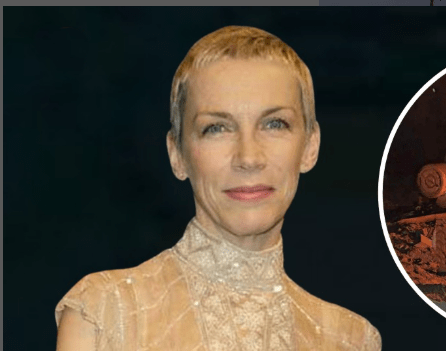Annie Lennox has always been more than just a singer. She is a performer who exemplifies tenacity, a storyteller whose voice transcends time, and a woman whose $60 million fortune attests to both artistry and foresight. But that figure doesn’t tell the whole story; it’s a testament to decades of hard work, extraordinarily successful innovation, and an exceptionally lasting impact.

Her adventure started with the Eurythmics, a bold partnership with Dave Stewart that changed the 1980s music landscape. Sweet Dreams (Are Made of This) and There Must Be an Angel, the duo’s anthems, not only topped the charts but also became enduring cultural icons. With over 80 million records sold, their catalog still brings in royalties, which is a very effective way for artists to make money that few can maintain for so long.
Annie Lennox – Profile and Financial Highlights
| Category | Details |
|---|---|
| Full Name | Ann Lennox (professionally known as Annie Lennox) |
| Date of Birth | December 25, 1954 |
| Birthplace | Aberdeen, Scotland |
| Nationality | Scottish |
| Education | Royal Academy of Music, London |
| Occupation | Singer, Songwriter, Musician, Activist |
| Net Worth (2025) | $60 million |
| Known For | Co-founder of Eurythmics, Solo Career |
| Major Hits | Sweet Dreams, There Must Be an Angel, Walking on Broken Glass, Why |
| Awards | 8 Brit Awards, 4 Grammys, Oscar, Golden Globe, Billboard Century Award |
| Honors | OBE (2011), UNESCO Goodwill Ambassador |
| Spouse | Mitch Besser (m. 2012) |
| Children | Lola and Tali (daughters), Daniel (stillborn son) |
| Real Estate | Homes in Los Angeles and London |
| Source | Celebrity Net Worth |
By the early 1990s, Lennox boldly ventured out on his own. Her first album, Diva, was not only a commercial success but also emotionally impactful, with tracks like “Why” expressing both strength and vulnerability in equal measure. Her longevity was validated by the record’s quadruple platinum status in the United Kingdom. In 1995, she followed it up with a covers album called Medusa, demonstrating that her artistic abilities were not limited by her synth-pop heritage. She won a Grammy for her eerie rendition of “No More “I Love You,” demonstrating how reinterpretation can be both economically successful and profoundly artistic.
She put out six solo albums over the years, each with a unique taste. Although less commercial, Nostalgia (2014), which examined American jazz standards, demonstrated her willingness to innovate. She avoided the artistic deterioration that frequently befalls celebrities who adhere too closely to past formulas by defying predictability and proving herself remarkably resilient.
With four Grammys, eight Brit Awards, a Golden Globe, and an Oscar for Into the West from The Lord of the Rings: The Return of the King, Lennox’s trophy cabinet speaks for itself. In addition to their prestige, these honors had financial benefits, such as increased touring costs, increased demand for appearances, and licensing opportunities. Credibility turns into money in the music industry, and Annie has fostered both with care.
But her influence goes beyond just music. She established The SING Campaign in 2007 to support HIV/AIDS-affected women and children. The goal of this activism was very clear; she used her position to draw attention to problems that are far too frequently overlooked. After receiving the OBE in 2011 for her humanitarian efforts, she went on to become a UNESCO Goodwill Ambassador. Her dedication has been especially creative, fusing music, influence, and personal conviction, in contrast to celebrity activism that sometimes feels performative.
Annie has also been prudent with money. Her portfolio of properties includes a $1.6 million mid-century bungalow in the area that she bought as a creative retreat and a $4.4 million modernist house in Los Angeles. Her £12 million Georgian mansion in London had significantly increased in value since she bought it. These decisions demonstrate a financially and emotionally fulfilling approach—homes as both sanctuaries and valuable assets.
Resilience has been a defining characteristic of her personal life. Despite the tragic death of her son Daniel in 1988, she raised her daughters Lola and Tali with remarkable grace. She found stability with Mitch Besser, whom she married in 2012, following two previous marriages. Her music was influenced by these life events, which gave it a deeper emotional quality that listeners naturally experienced. She was financially successful and famous as an artist because of her gift of turning personal sorrow into universal songs.
Her distinct path is highlighted by comparisons with her contemporaries. Stevie Nicks mastered mystique, Cyndi Lauper leaned into eccentricity, and Madonna frequently courted shock value. However, Lennox combined activism, intelligence, and androgyny to create a brand that was incredibly dependable and long-lasting. Her cultural significance endures, as evidenced by the fact that even more recent icons like Lady Gaga and Florence Welch mention her as an influence.
In recent years, streaming has emerged as an unexpected ally. Even though physical album sales have drastically decreased, millions of royalties are still earned from the continuous playback of songs like “Walking on Broken Glass” and “Sweetheart Dreams” on websites like Spotify. Back catalogs are living, breathing resources that generate income for legacy artists like Annie, not artifacts.
In a larger cultural context, Annie Lennox’s wealth reflects a unique fusion of financial savvy, artistic vision, and activism. Instead, she chose durability and purpose over the careless spending that engulfed many of her peers. Her experience demonstrates how social responsibility combined with financial security can produce an influence that is both highly regarded and intensely personal.
